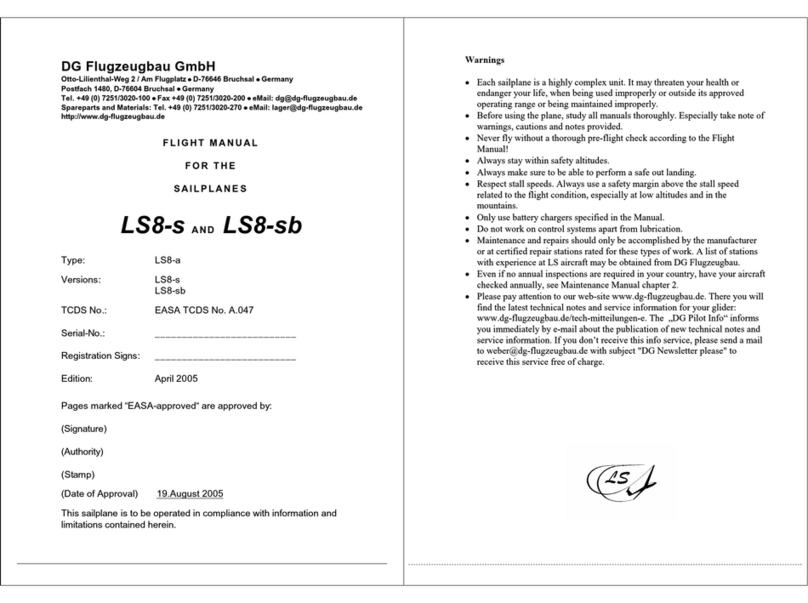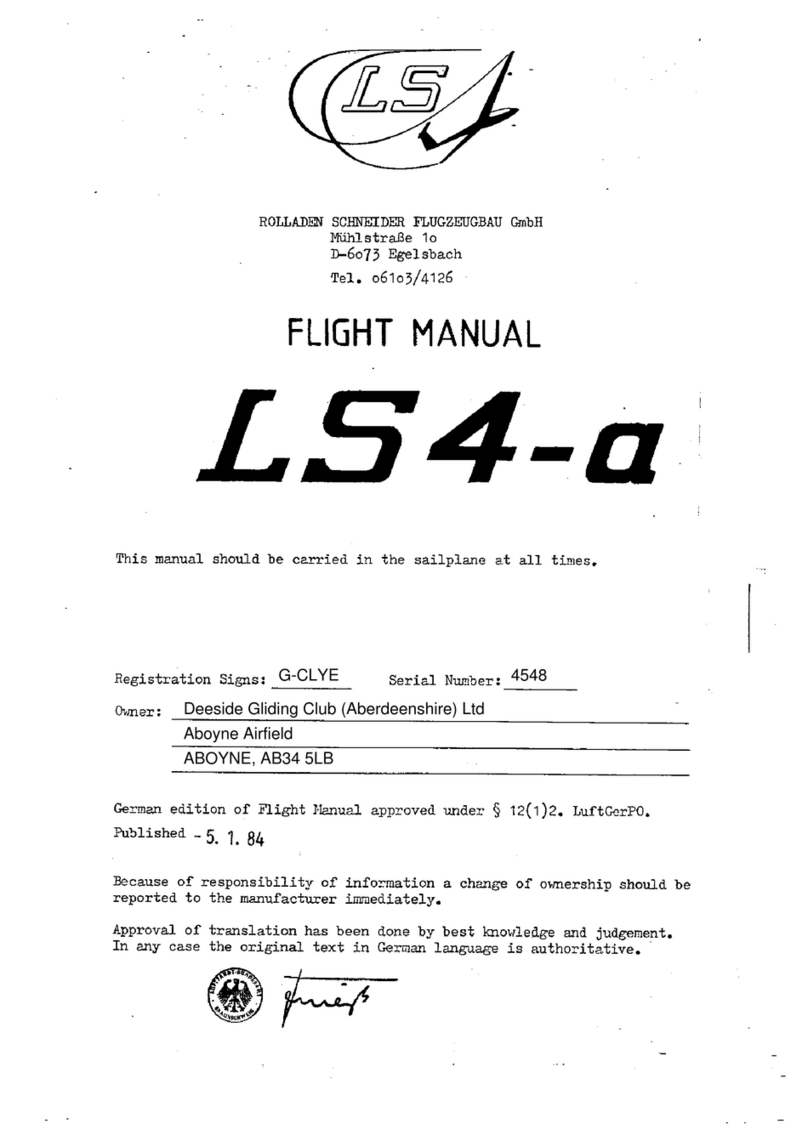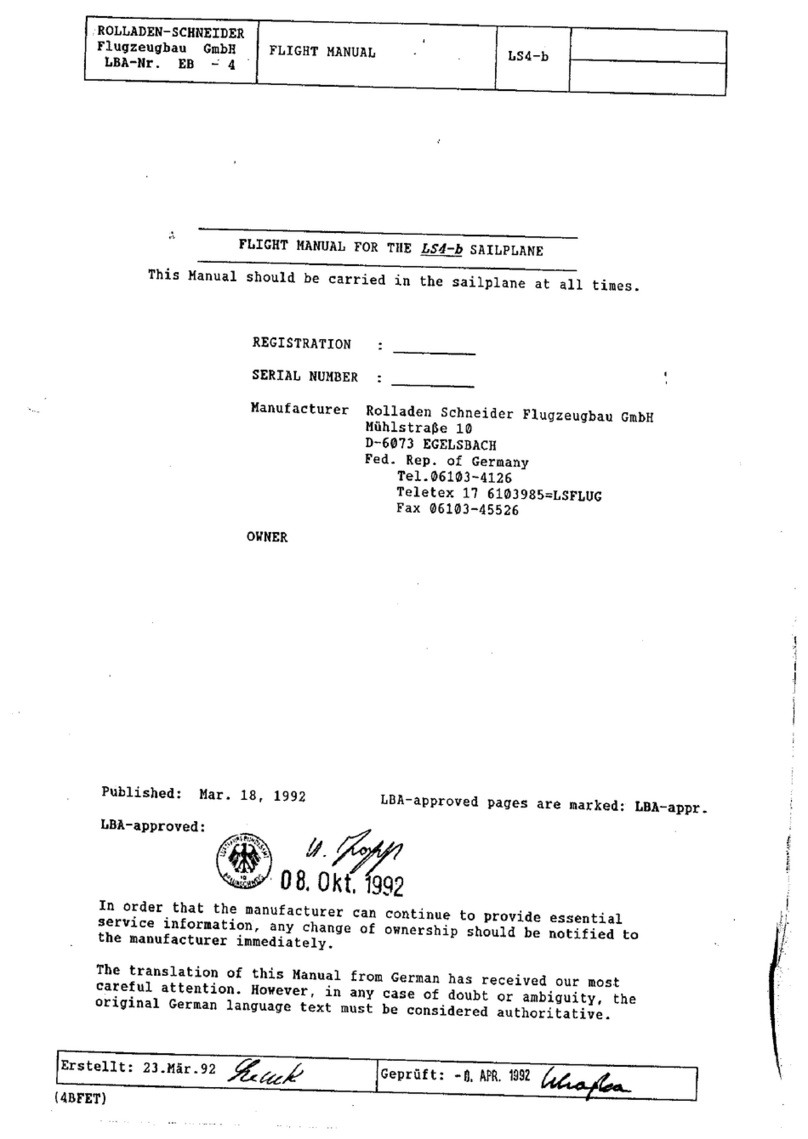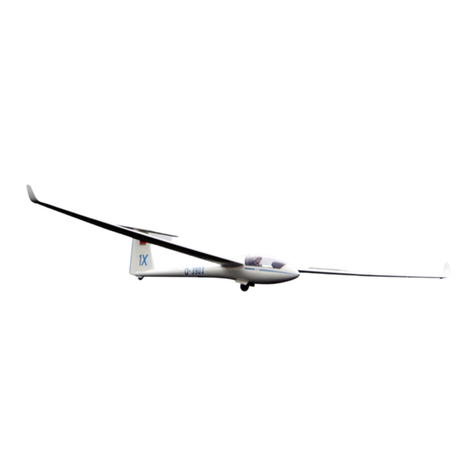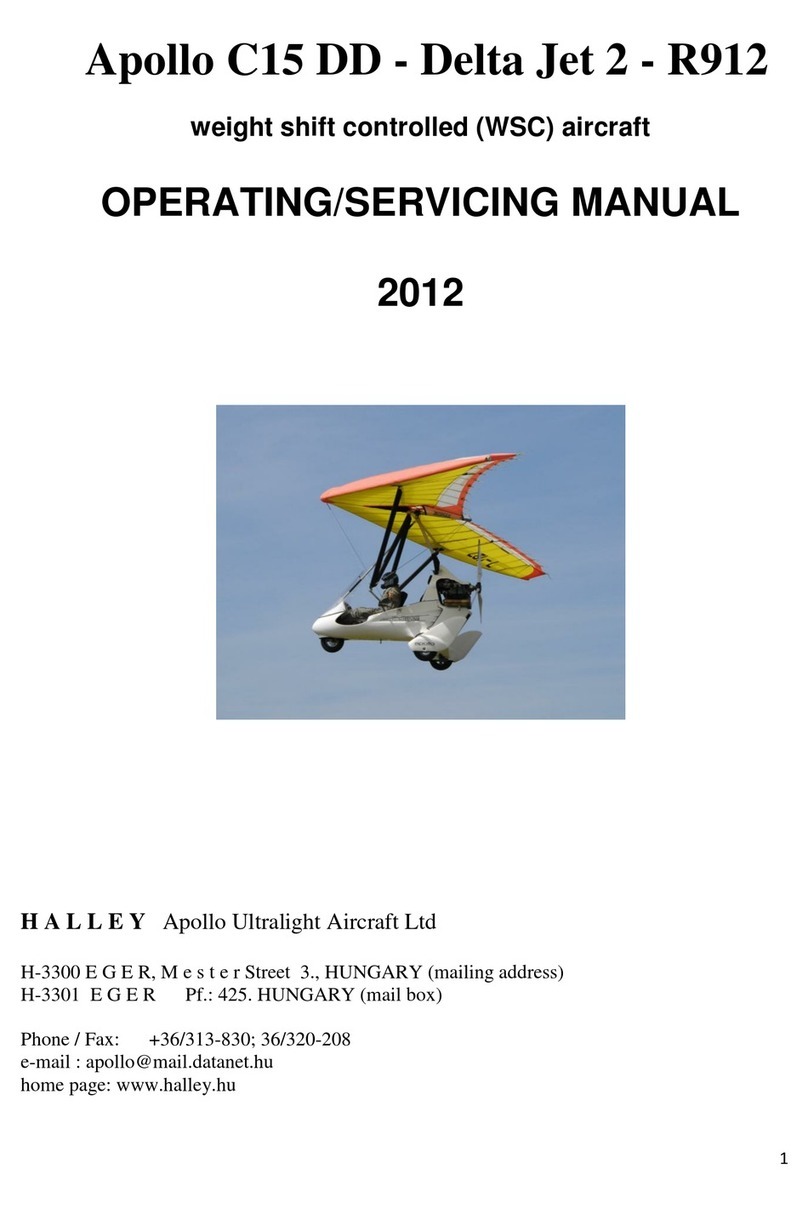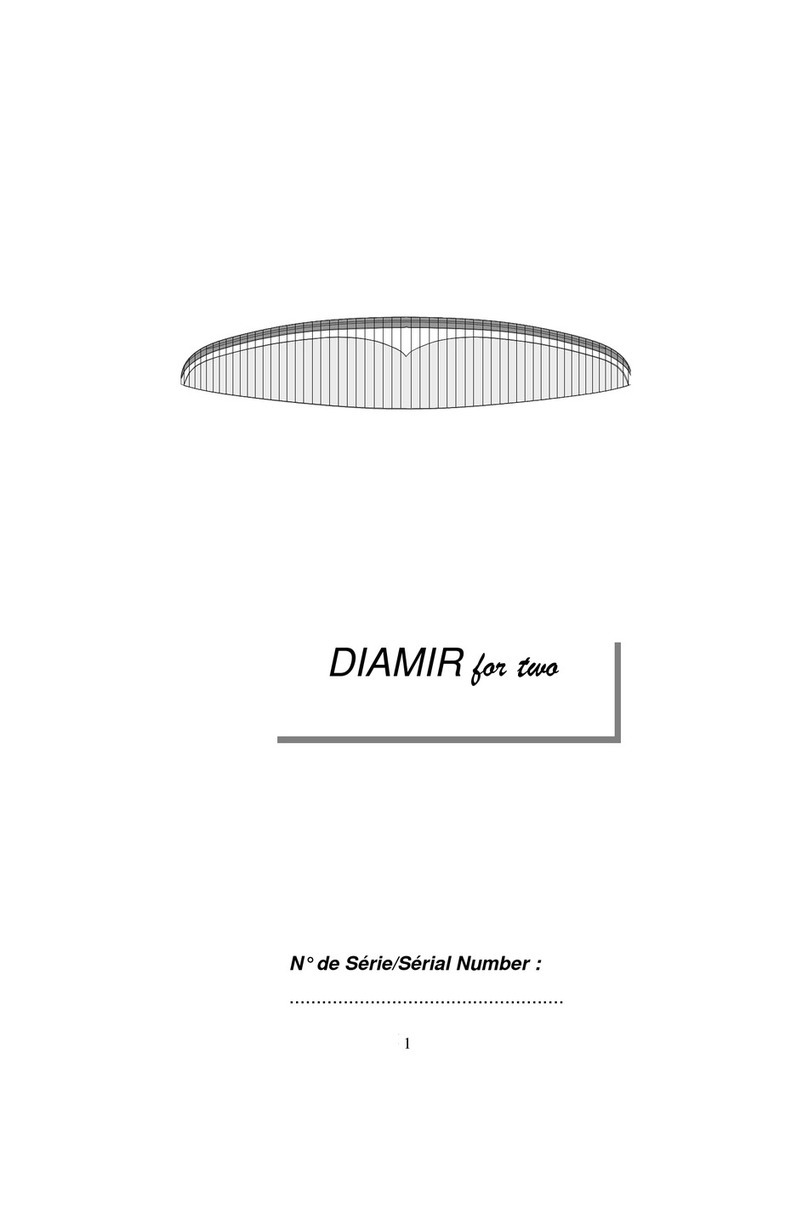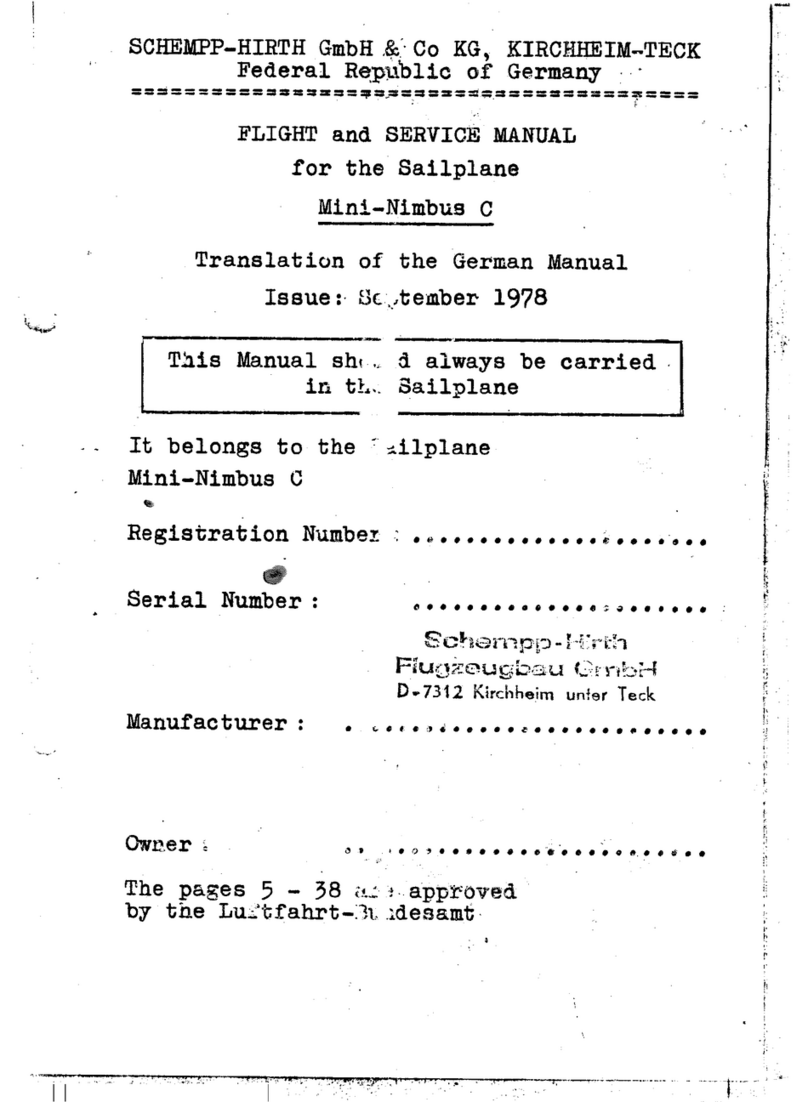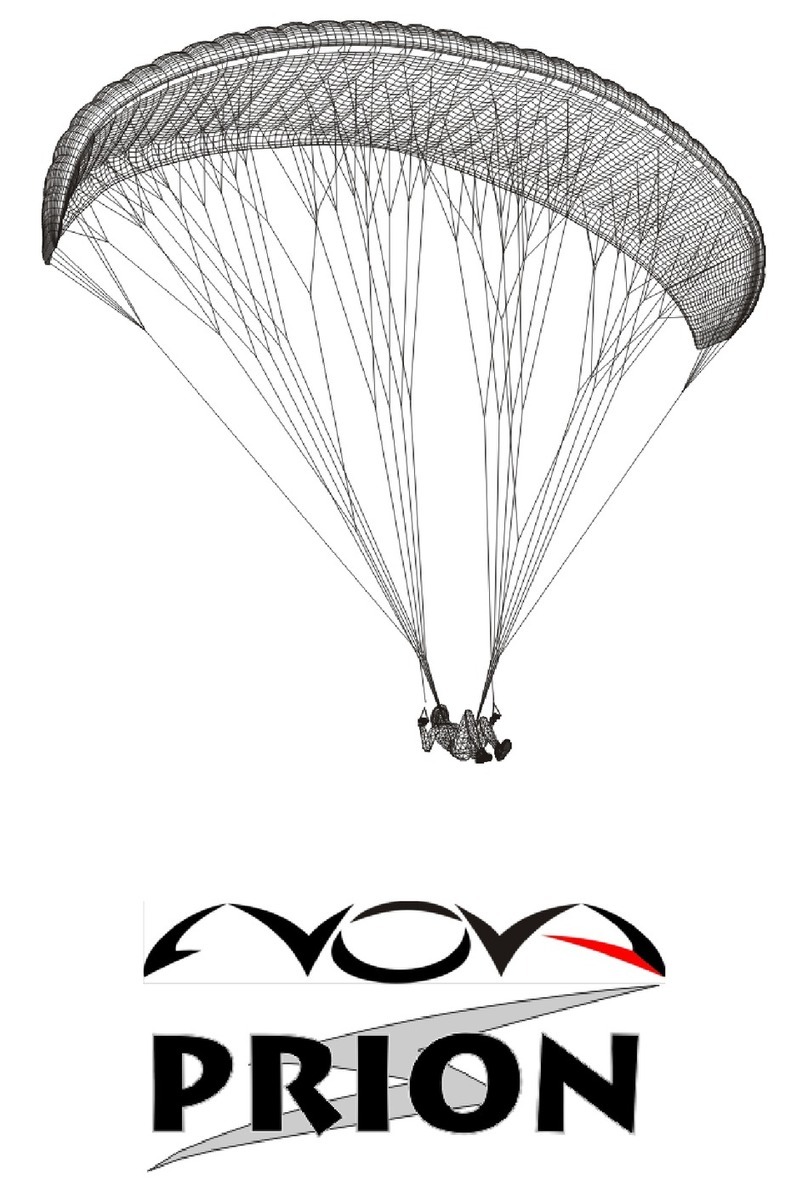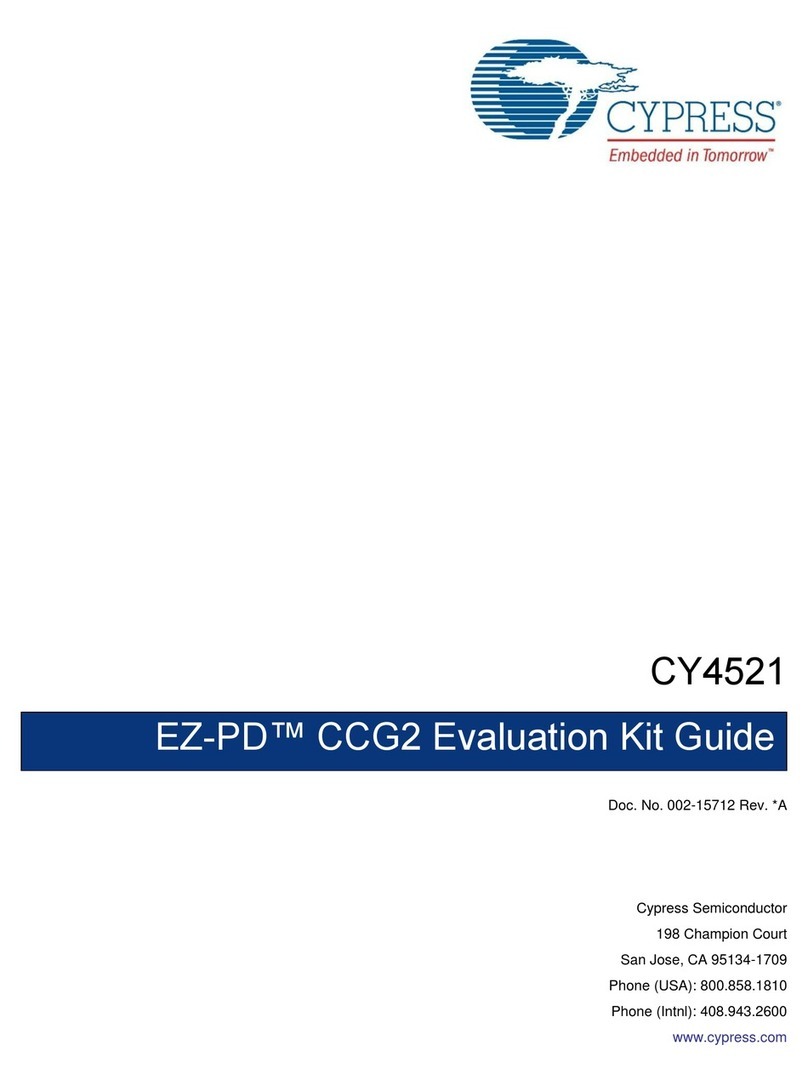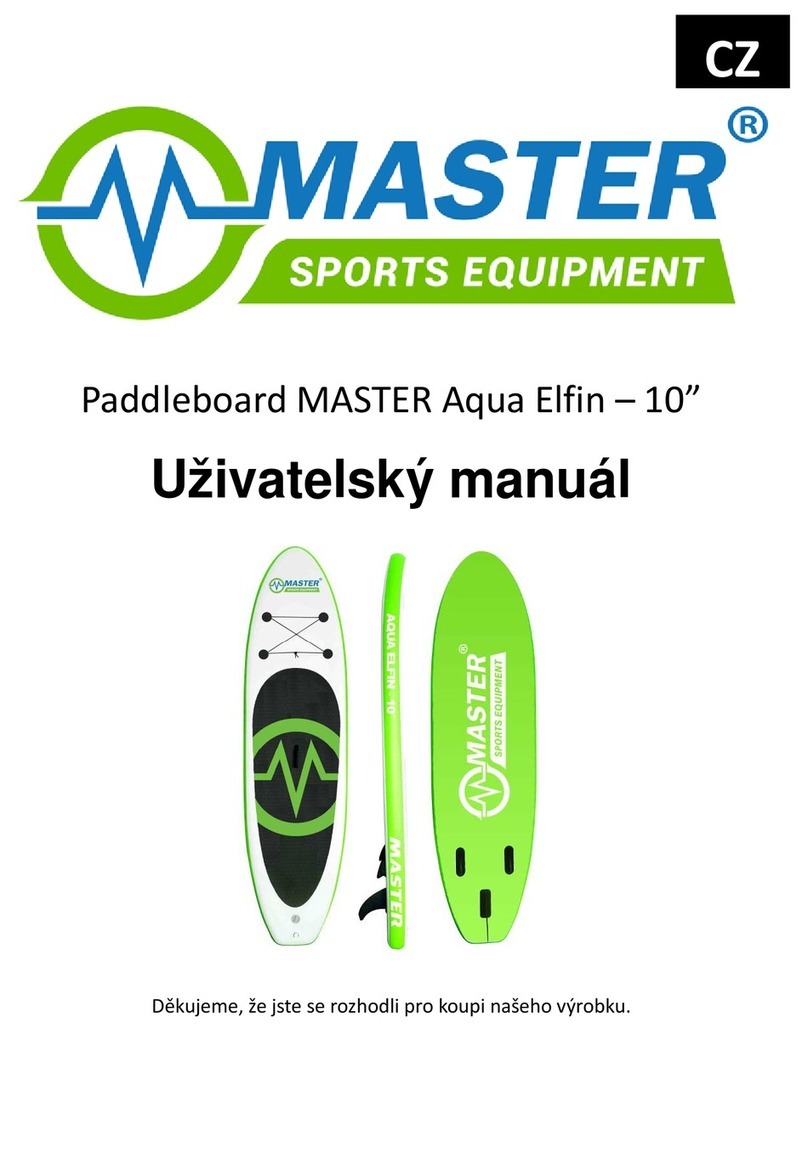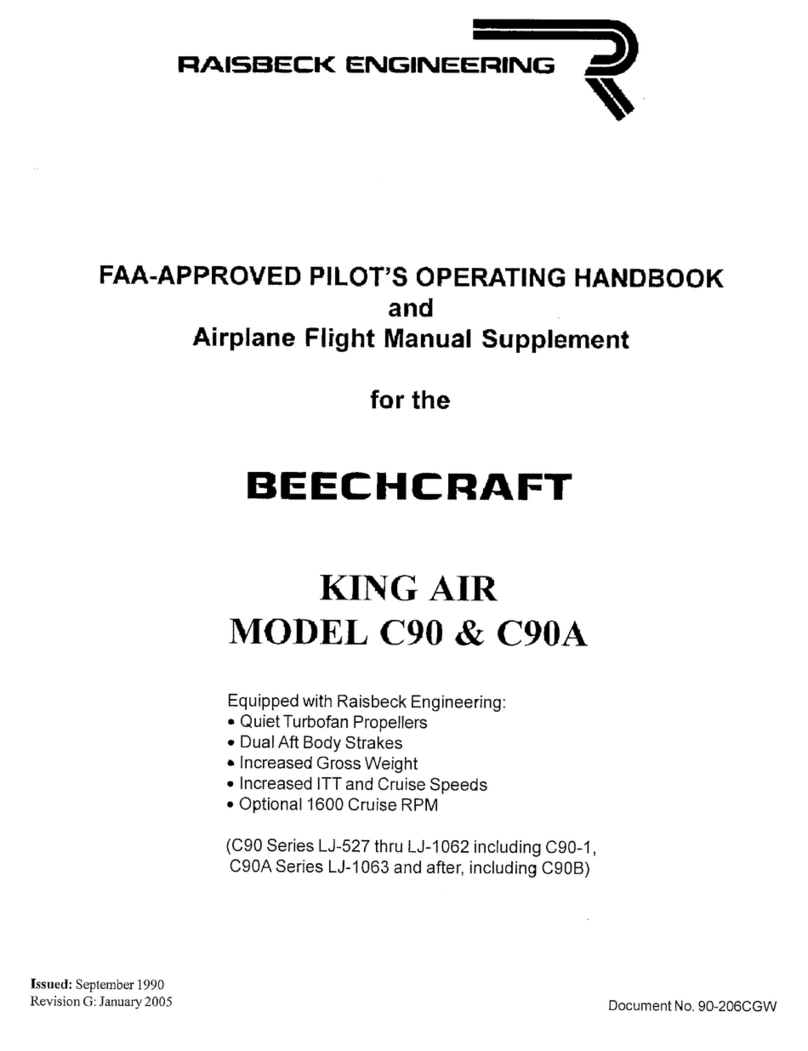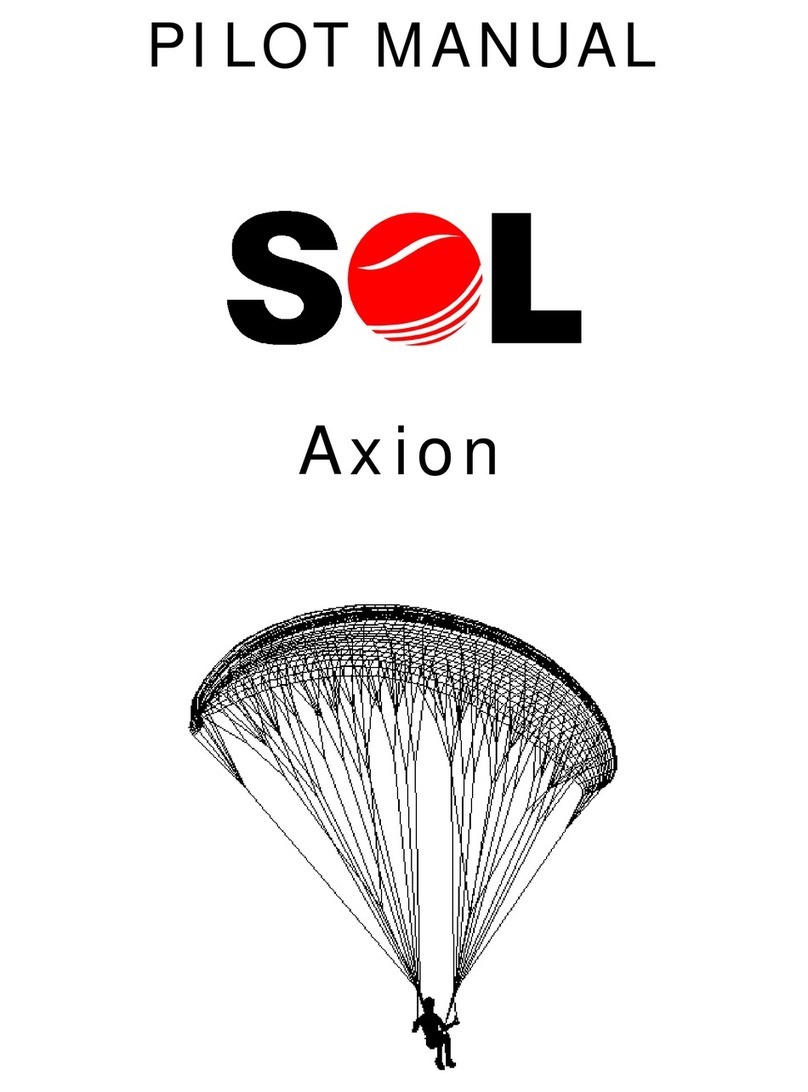Rolladen-Schneider LS 8-18 Technical specifications

DG Flugzeugbau GmbH, Otto-Lilienthal-Weg 2, D-76646 Bruchsal
Tel. +49 (0)7251-3020 100, Fax +49 (0)7251-3020 200
Flight Manual for the
LS 8-18 Sailplane
This Manual should be carried in the sailplane at all times.
Registration: __________ Serial Number: ___________
Owner:
Edition: July 1999
This sailplane is to be operated in compliance with information and limitations contained herein.
In order that the manufacturer can continue to provide essential service information, any change of
ownership should be notified to the manufacturer immediately.
The translation of this manual has received our most careful attention. However, in any case of doubt or
ambiguity, the original German text must be considered authoritative.
Approved as an Operating Instruction according to JAR 22.

DG Flugzeugbau GmbH Flight Manual LS 8-18 General
0 Manual Contents
0.1 Log of Revisions
Any revision of the present manual, except actual weighing data, must be recorded in the following table
and in case of approved Sections endorsed by the responsible airworthiness authority.
The new or amended text in the revised page will be indicated by a black vertical line in the right hand
margin, and the revision No. and the date will be shown on the bottom left hand of the page.
Rev.
No.
Pages affected Description Date LBA
Approval
1 0-2, 0-3, 1-1, 2-3, 2-4,
2-5, 2-6, 2-8, 3-4, 4-2,
4-3, 4-4, 4-5, 4-8, 4-9,
4-12, 5-3, 6-1, 6-2, 8-3
TN8011
removal of tail fin battery
may be used for trimming
Dec. 2001 25.01.2002
Rev.
No.
Pages affected Description Date EASA
Approval
2 0-2, 0-3, 4-7, 4-13, 4-14,
7-2
TN8019 wheel brake actuated by
airbrake handle
Feb. 2011 13.10.2011
3 0-2, 0-3, 4-3, 4-9 TN8020, retrofit of a 5” landing gear Sept. 2011 14.10.2011
Edition: September 2011 Revision – 3 (TN8020) Page 0-2

DG Flugzeugbau GmbH Flight Manual LS 8-18 General
0.2 List of Effective Pages
Chapter Page Date Chapter Page Date
0 Title page July 1999 4 4-14 February 2011
0-1 July 1999 4-15 July 1999
0-2 September 2011 4-16 July 1999
0-3 September 2011 4-17 July 1999
0-4 July 1999
5 5-1 July 1999
1 1-1 Dec. 2001 5-2 July 1999
1-2 July 1999 5-3 Dec. 2001
6 6-1 Dec. 2001
2 2-1 July 1999 6-2 Dec. 2001
2-2 July 1999
2-3 Dec. 2001
2-4 Dec. 2001
2-5 Dec. 2001 7 7-1 July 1999
2-6 Dec. 2001 7-2 February 2011
2-7 July 1999 7-3 July 1999
2-8 Dec. 2001 7-4 July 1999
7-5 July 1999
7-6 July 1999
3 3-1 July 1999
3-2 July 1999
3-3 July 1999 8 8-1 July 1999
3-4 Dec. 2001 8-2 July 1999
3-5 July 1999 8-3 Dec. 2001
3-6 July 1999 8-4 July 1999
8-5 July 1999
8-6 July 1999
4 4-1 July 1999
4-2 Dec. 2001
4-3 September 2011 9 9-1 July 1999
4-4 Dec. 2001
4-5 Dec. 2001
4-6 July 1999
4-7 February 2011
4-8 Dec. 2001
4-9 September 2011
4-10 July 1999
4-11 July 1999
4-12 Dec. 2001
4-13 February 2011
Edition: September 2011 Revision – 3 (TN8020) Page 0-3

DG Flugzeugbau GmbH Flight Manual LS 8-18 General
0.3 Table of Contents
No. Section Approval Status
1 General.................................................................................................................non-approved
2 Limitations..................................................................................................................approved
3 Emergency Procedures..............................................................................................approved
4 Normal Procedures ....................................................................................................approved
5 Performance .....................................................................................................partly approved
6 Weight and Balance ............................................................................................non-approved
7 Description of Systems) ......................................................................................non-approved
8 Handling, Servicing and Maintenance ..............................................................non-approved
9 Supplements.........................................................................................................non-approved
Edition: July 1999 Revision - 0 Page 0-4

DG Flugzeugbau GmbH Flight Manual LS 8-18 General
1 General
Contents of Section 1:
1 General .......................................................................................................... 1-1
1.1 Introduction ................................................................................................ 1-1
1.2 Certification Basis ...................................................................................... 1-1
1.3 Warnings, Cautions and Notes (Definitions).............................................. 1-1
1.4 Descriptive and Technical Data.................................................................. 1-2
1.5 Three View Drawing .................................................................................. 1-2
1.1 Introduction
This sailplane Flight Manual has been prepared to provide pilots and instructors with information for the
safe and efficient operation of the LS 8-18 sailplane.
This manual includes the material required to be furnished to the pilot by JAR Part 22. It also contains
supplementary data supplied by the sailplane manufacturer.
The LS8-18 is a high performance sailplane, not a basic trainer. However excellent in design, construction,
performance and handling qualities, flying it requires a skilled pilot, who observes the limitations and
recommendations set out in this manual.
1.2 Certification Basis
This type of sailplane has been approved by Luftfahrt-Bundesamt (LBA) Braunschweig in accordance with
JAR-22 dated 28. October 1985, (Change 5), with the exemption of JAR 22.49(b)(2)(ii), stalling speed with
air brakes extended at maximum all-up weight for the 15 m version.
The LBA-Type Certificate No. 402 for LS 8-18 was issued on 20. Jan. 2000 .
Category of Airworthiness: "Utility".
This Flight Manual constitutes a FAA Approved Flight Manual for US registered sailplanes in accordance
with CFR Part 21.29.
1.3 Warnings, Cautions and Notes
The following definitions apply to warnings, cautions and notes used in the Flight Manual
Warning: Means, that the non-observation of the corresponding procedure
leads to an immediate or important degradation of the flight safety.
Cautions: Means, that the non-observation of the corresponding procedure leads to
a minor or to a more or less long term degradation of the flight safety.
Notes: Draws the attention to any special item not directly related to safety, but
which is important or unusual.
Edition: Dec. 2001 Revision – 1 (TB 8011) Page 1-1

DG Flugzeugbau GmbH Flight Manual LS 8-18 General
1.4 Descriptive and Technical Data
The LS 8-18 is a single seater sailplane with carbon fibre wing shell, winglets, T-tail, wing and
vertical tail fin water ballast systems, retractable and sprung landing gear, and upper wing surface
air brakes. The LS8-18 may be operated in 15m or 18m span and winglets in both versions
This sailplane has been produced using the latest technology of industrial fibre design (Glass-,
Aramid- and Carbon fibres).
It is designed for competition flights – high performance combined with excellent handling
characteristics.
Wing span 15m 49.21ft 18m 59.6ft
Length 6.66m 21.84ft 6.66m 21.84ft
Height 1.33m 4.36ft 1.33m 4.36ft
MAC 0.700m 2.3ft 0.634m 2.08ft
Wing area 10.5 m² 113.0sq.ft 11.4 m² 122.9sq.ft
Wing aspect ratio 21.43 21.43 28.38 28.38
Maximum gross weight 525kg 1157lbs 525 kg 1157lbs
Maximum wing loading 50.0 kg/m² 10.3lbs/sq.ft 46.1 kg/m² 9.4lbs/sq.ft
1.5 Three View Drawing
Edition: July 1999 Revision - 0 Page 1-2

DG Flugzeugbau GmbH Flight Manual LS 8-18 Limitations
2 Limitations
Contents of Section 2:
2 Limitations ................................................................................... 2-1
2.1 Introduction................................................................................ 2-1
2.2 Airspeeds (IAS) ........................................................................ 2-2
2.3 Airspeed Indicator colour markings .......................................... 2-3
2.4 Mass (Weight) ........................................................................... 2-4
2.5 Centre of Gravity Limits ........................................................... 2-5
2.6 Manoeuvre Limits, Category of Airworthiness ........................ 2-5
2.7 Manoeuvring Load Factors ....................................................... 2-5
2.8 Kinds of Operation Limits ........................................................ 2-6
2.9 Flight Crew ............................................................................... 2-6
2.10 Minimum Equipment List ....................................................... 2-7
2.11 Aero Tow, Winch Launch and Auto Tow................................ 2-7
2.12 Further Limitations .................................................................. 2-8
2.12.1 Operating Placards for Limitations .................................... 2-8
2.12.2 Approved Gelcoats for Exterior Surfaces .......................... 2-8
2.12.3 Use of Water for Ballast ..................................................... 2-8
2.1 Introduction
Section 2 includes operating limitations, instrument markings and basic placards necessary for safe
operation of the LS8-18 sailplane, its standard systems and standard equipment.
The limitations included in this section and in section 9 have been approved by LBA (Luftfahrt-
Bundesamt Braunschweig).
The LS 8-18 sailplane has been designed and approved according to JAR 22 requirements. Factors
of safety (relation of ultimate loads to permissible maximum loads occurring during operation) are
1.5 only. Thus, ultimate loads will be reached, when exceeding permissible load factors by 50%.
When exceeding permissible speeds, the safety reserve is much lower.
Maximum loads should never be caused by the pilots control surface deflections – they result from
severe turbulence and the necessary control surface deflections to retain the desired flight attitude.
Severe turbulence according to airworthiness requirements includes wave rotors, cumulonimbus
clouds, dust devils and turbulence when crossing mountain ridges in strong winds.
Warning: Therefore, operational limits, - speeds and load factors - must be adhered to !
Edition: July 1999 LBA-appr. Revision - 0 Page 2-1

DG Flugzeugbau GmbH Flight Manual LS 8-18 Limitations
2.2 Airspeeds (IAS)
Airspeed limitations and their operational significance are shown below:
Maximum permissible
Speed
IAS
Remarks
VNE
Never exceed speed in
calm air and up to an
altitude above MSL of:
Km/h Kt. mph
Do not exceed this speed in any operation
and do not use more than 1/3 of control
deflection.
2000m ( 6500ft) 280 151 174
3000m ( 9800ft) 266 144 165
4000m (13100ft) 253 137 157
6000m (19700ft) 227 122 141
8000m (26200ft) 202 109 126
10000m (32800ft) 179 97 111
12000m (39400ft) 156 84 97
VRA Rough air speed 190 103 118
Do not exceed this speed except in calm air
and then only with caution.
Examples of rough air are lee wave rotor,
thunderclouds, dust devils and turbulence
when crossing mountain ridges in strong
winds.
VA Manoeuvring speed 190 103 118
Do not make full or abrupt control movement
above this speed, because under certain
conditions the sailplane may be overstressed
by full control movement.
VW Maximum winch-
launching speed
140 76 87
Do not exceed this speed during winch- or
auto-tow launching.
VT Maximum aero towing
speed
190 103 118
Do not exceed this speed during aero towing.
VL0 280 151 174
Maximum landing gear
operating speed
Do not extend or retract the landing gear
above this speed.
Maximum air brake
extension speed
280 151 174
Edition: July 1999 LBA-appr. Revision - 0 Page 2-2

DG Flugzeugbau GmbH Flight Manual LS 8-18 Limitations
2.3 Airspeed indicator colour markings
Airspeed indicator markings and their colour- code significance are shown below:
Marking (IAS)value or range Significance
Green arc 97-190 km/h Normal Operating range.
52-103 Kt.
60-118 mph
Yellow arc 190-280 km/h
103-151 Kt.
118-174 mph
Manoeuvres must be conducted with caution and only in
smooth air.
Red line 280 km/h
151 Kt.
174 mph
Maximum speed for all not restricted operations.
Yellow 90 km/h
triangle 49 Kt.
56 mph
Recommended minimum approach speed at maximum
weight without water ballast
For an example of airspeed indicator colour marking see below.
Airspeed Indicator, diameter 80 mm <3.15 in>.
(This type of marking is not possible with 57 mm <2.24 in> diameter.)
green
yellow
red
red altitude related VNE markings,
here in km
Without altitude related VNE
markings on the dial, a VNE placard
according to page 2-8 must be on the
instrument panel.
Edition: Dec. 2001 LBA-appr. Revision – 1 (TB 8011) Page 2-3

DG Flugzeugbau GmbH Flight Manual LS 8-18 Limitations
2.4 Mass (Weight)
Maximum take-off mass including water ballast ...................525 kg 1157 lbs
Maximum mass without water ballast ...................412 kg 908 lbs
Recommended landing mass ...................500 kg 1102 lbs
Warning: It is recommended to discharge water ballast before each landing. Pilots are
advised against landing with maximum all-up mass. When flying with maximum
all-up mass, at least 25 Litres –6.6 US gallons, 5.5 Imp. gallons - (corresponding
to about 15 Seconds of discharge time) should be discharged.
Maximum mass of non-lifting parts ...................239 to 249 kg 527 to 549 lbs
Value must be determined according to table in Maintenance Manual, chapter 2, related to empty
mass and empty mass C.G. position. The term “non-lifting” parts includes the following:
•Fuselage
(with permanently installed instruments, canopy and main pins)
•Cockpit load
(Pilot + parachute + equipment <for instance tail fin battery in baggage compartment>)
•Horizontal tail
Water ballast and battery in tail fin do not count for “non-lifting” parts, but for maximum
all-up weight.
Wing water ballast (depending on loading conditions) ......... max. 190 kg 419 lbs
Warning: Wing water ballast must always be compensated by tail fin water ballast according to table
page 4-12 .
Tail fin water ballast (depending on wing water ballast)
Without tail fin battery box ............ maximum 5.5 kg 12 lbs
With tail fin battery box ............ maximum 3.8 kg to 4.1 kg 8.4 to 9 lbs
Integral tail fin tank ............. maximum 12 kg 26 lbs
Maximum mass in Baggage Compartment ...........max. 5.0 kg 11 lbs
Maximum mass of all instrument panel installations ...........max. 6.7 kg 14.8 lbs
Warning: The vertical tail fin battery may be removed from the tail fin to reduce
Minimum Cockpit Load (see entries on page 6-1/2 for possible combinations !)
Edition: Dec. 2001 LBA-appr. Revision – 1 (TB 8011) Page 2-4

DG Flugzeugbau GmbH Flight Manual LS 8-18 Limitations
2.5 Centre of Gravity Limits
Datum Point: Leading edge of wing at root, when under side of fuselage boom is placed horizontal.
Maximum allowable forward C.G.
Position at maximum Mass:
280 mm <11.024 in>
aft of Datum
Maximum allowable rearward C.G.
Position:
400 mm <15.748 in>
aft of Datum
Take-off C.G. position
[mm aft of Datum]
Warning: Vertical tail fin water ballast must be used to compensate C.G. displacement due
to wing water ballast, surplus may be used to compensate pilot weight above
Minimum Cockpit Load !
Maximum amounts see pages 4-11/12.
2.6 Approved manoeuvres / Category of Airworthiness
The LS 8-18 sailplane is certified in the U ("Utility") category according to JAR 22.
Aerobatic flight not approved.
2.7 Manoeuvring load factors
At 190 km/h, 103Kt., 118 mph............................................. 5.3 g positive to 2.65 g negative
At 280 km/h, 151 Kt., 174 mph (Air brakes retracted) ........ 4.0 g positive to 1.5 g negative
At 280 km/h, 151 Kt., 174 mph (Air brakes extended)........ 3.5 g positive to 0.0 g negative
Edition: Dec. 2001 LBA-appr. Revision – 1 (TB 8011) Page 2-5

DG Flugzeugbau GmbH Flight Manual LS 8-18 Limitations
2.8 Kinds of operation
The LS8-18 sailplane is approved for Day-VFR
........................................Minimum equipment see page 2-7
Use of water ballast limited to non-freezing conditions.
Additives to water ballast not approved.
Cloud flying only approved without water ballast
Applicable only only for countries, which permit cloud flying and when minimum equipment is
certified for cloud flying, see inspectors entry in inspection certificate.
........................................Minimum equipment see page 2-7.
For USA only:
Night-VFR, IFR and Flight into known icing conditions are not approved.
2.9 Flight crew
Maximum cockpit load (Pilot + parachute + baggage + temporary
equipment + tail fin battery in baggage comp.) ........... 110 kg, 242 lbs
See entry on page 6-1/2
Oxygen equipment see page 7-6
Minimum cockpit load (Pilot plus parachute, no baggage, no temporary equipment)
See entry on page 6-1/2
for club use and normally without tail tank
no trim ballast............................................ 70 kg, 154 lbs
with 3 trim weights.................................... 55 kg, 121 lbs
(1 Trim weight - 2.5kg, 5.5lbs - corresponds to 5 kg, 11 lbs of Cockpit load)
If the sailplane does not fly in a club, it may be trimmed for a higher minimum cockpit
load. See instructions in Maintenance Manual chapter 11.
Warning: For reasons of safety, the cockpit placarded Minimum Cockpit Load in large
digits includes the full tail fin tank ballast and tail fin battery weights.
Lighter pilots must positively check the following:
a) Tail tank empty: with discharge lever in open position the valve is really
open
(with discharge lever in open position air can be blown
through valve)
b) Tail battery not installed (Check by removing horizontal tail and re-
installation !)
For possible combinations see Flight Manual entries on pages 6-1/2.
Edition: Dec. 2001 LBA-appr. Revision – 1 (TB 8011) Page 2-6

DG Flugzeugbau GmbH Flight Manual LS 8-18 Limitations
2.10 Minimum Equipment List
•Airspeed Indicator: scale 50-300 km/h (27-162 Kt.; 31-186 mph)
Colour marking see page 2-3.
Approved types see Master Equipment List in Maintenance Manual.
Pressure pick-ups: vertical tail fin pitot and lower forward fuselage side statics.
•Altimeter: scale in m or ft.
•Remote indicating thermometer: approved types see Master Equipment List in Maintenance Manual.
•Four piece seat belt harness: approved types see Master Equipment List in Maintenance Manual.
•Vertical tail filling tube adapter: for checking of tail fin tank valve function (one of three removable
filling funnel adapters)
•Magnetic compass: (for USA and Canada)
•Back cushion or parachute, in compressed form not thinner than 5 cm (2 in)
•Checklist, Type placard, Data and loading placard, Operating placards
•Flight Manual LS8-18
Additionally for cloud flying:
•Airspeed Indicator: recommended: scale 50-300 km/h with 1 turn only (27-162 Kt.; 30-186 mph)
•Turn and bank indicator
•Compass, compensated in sailplane
•Variometer: recommended: range at least ±10 m/s (2000 ft/min; 20 Kt.)
2.11 Aero tow, Winch-launch and Auto-tow
Maximum approved winch-launch speed:....140 km/h (76 Kt.; 87 mph)
(also valid for Auto-tow)
Maximum approved aero tow speed:....190 km/h (103 Kt.; 118 mph)
Weak links
for winch-launch.............................. maximum 8250 Newton (825 kg; 1819 lbs)
Recommended: Tost weak link No. 3, colour code red,
.......................................rated break away load 7500 Newton (750 kg; 1653 lbs)
for aero tow.............................. maximum 6600 Newton (660 kg; 1455 lbs)
Recommended: Tost weak link No. 5, colour code blue,
rated break away load 6000 Newton (600 kg; 1323 lbs)
Minimum tow cable length for aero tow ..........................30 m (100 ft)
recommended length .................up to 80 m (260 ft)
Important Note: During motor glider tow, limitations regarding weak link and tow cable length
must be obeyed.
Edition: July 1999 LBA-appr. Revision - 0 Page 2-7

DG Flugzeugbau GmbH Flight Manual LS 8-18 Limitations
2.12 Further Limitations
2.12.1 Operating Placards for Limitations
Rolladen Schneider Flugzeugbau GmbH
Type: LS 8-18 Serial No.:_______ M I N I M U M C O C K P I T L O A D:____ kg / lbs
Data Placard
Minimum Cockpit Load with empty tail tank: ____ kg / lbs
Airspeed Limits: km/h mph Kt. under instrument panel cover
Winch launch/Auto tow 140 87 76
Aero tow 190 118 103
In rough air 190 118 103 Maximum baggage weight 5kg (11 lbs)
Never exceed (VNE) 280 174 151 (Soft items only)
Max. Take-off mass 525 kg ; 1157 lbs at baggage compartment
Aerobatic manoeuvres not approved
Weight Limitations
Altitude related VNE speeds above MSL
Maximum Cockpit Load ....max.______kg/lbs m ft km/h mph Kt.
Minimum Cockpit Load min. ______kg/lbs Up to 2000 ( 6500) - 280 174 151
Minimum Cockpit Load with Up to 3000 ( 9800) - 266 165 144
empty tail tank Up to 4000 (13100) - 253 157 137
and without tail battery min.:______kg/lbs Up to 6000 (19700) - 227 141 122
Minimum Cockpit Loads for all combinations Up to 8000 (26200) - 202 126 109
of tail tank and tail battery see Flight Manual Up to 10000 (32800) - 179 111 97
pages 6-1/2. Up to 12000 (39400) - 156 97 84
Lighter pilots must compensate lack of weight near airspeed indicator
as suggested in Flight Manual (unless marked according to page 2-3)
2.12.1 Approved Gelcoat colours for exterior surfaces
All external portions of the glider must be painted white except of wingtips, nose of fuselage and rudder.
Approved gelcoat: UP-Gelcoat Scheufler T35 white
Tone similar to RAL 9010
2.12.3 Use of water for ballast
Use of water for ballast restricted to clear water without any additives.
Edition: Dec. 2001 LBA-appr. Revision – 1 (TB 8011) Page 2-8

DG Flugzeugbau GmbH Flight Manual LS 8-18 Emergency Procedures
3 Emergency Procedures
Contents of Section 3:
3 Emergency procedures............................................................................... 3-1
3.1 Introduction............................................................................................. 3-1
3.2 Emergency Canopy Jettison.................................................................... 3-1
3.3 Emergency Exit....................................................................................... 3-2
3.4 Stall Recovery......................................................................................... 3-2
3.5 Spin Recovery ........................................................................................ 3-3
3.6 Spiral Dive Recovery ............................................................................. 3-3
3.7 Other Emergencies ................................................................................. 3-4
3.7.1 Limitation of High Speed Flight .......................................................... 3-4
3.7.2 Rain ..................................................................................................... 3-4
3.7.3 Inadvertent Freezing / Icing ................................................................ 3-4
3.7.4 Flight with asymmetric water ballast loading ..................................... 3-5
3.7.5 Winch-launch cable failure .................................................................. 3-5
3.7.6 Emergency landing with landing gear retracted................................... 3-5
3.7.7 Ground loop ......................................................................................... 3-5
3.7.8 Emergency landing in water ............................................................... 3-6
3.7.9 Flight in the vicinity of thunder storms................................................ 3-6
3.1 Introduction
Section 3 provides checklist and amplified procedures for coping with emergencies that may
occur. Emergencies caused by sailplane malfunction are extremely rare if proper pre-flight
inspections and maintenance are practised.
However, should an emergency arise, the basic guidelines described in this section should be
considered and applies as necessary to correct the problem.
3.2 Emergency Canopy Jettison
Canopy locks : pull both red and white handles to stops
- Right handle operates emergency canopy jettison, therefore
longer travel as on left handle.
- Hand force increases for emergency jettison travel to avoid
unintentional jettison during normal operation.
Canopy : push off at both red and white handles
- Lifting panel assists pushing off.
- spring loaded peg at canopy frame rear edge acts as
temporary hinge for clean separation from fuselage.
Edition: July 1999 LBA-appr. Revision - 0 Page 3-1

DG Flugzeugbau GmbH Flight Manual LS 8-18 Emergency Procedures
3.3 Emergency Exit
Canopy - jettison
Seat harness - open
Exit - Lift with arms over cockpit rim
push yourself away from the sailplane
- preferably dive under wing, to avoid the tail
3.4 Stall Recovery
Warning - slight tail shudder prior to entry
Aileron - effectiveness reduced by about 50%
Sink rate - increases considerably
Termination - Stick forward to neutral
Stalling speed - at maximum weight (525 kg, 1157 lbs),
straight flight and air brakes retracted:
83 km/h (45 Kt.; 52 mph) with 15 m (49 ft) wingspan
80 km/h (43 Kt.; 50 mph) with 18 m (59 ft) wingspan
air brakes extended:
87 km/h (47 Kt.; 54 mph) with 15 m (49 ft) wingspan
85 km/h (46 Kt.; 53 mph) with 18 m (59 ft) wingspan
When during stalled flight the angle of incidence is increased considerably by further “pulling”,
then –depending on C.G. position- spinning may result from asymmetric stall.
Edition: July 1999 LBA-appr. Revision - 0 Page 3-2

DG Flugzeugbau GmbH Flight Manual LS 8-18 Emergency Procedures
3.5 Spin Recovery
Simultaneously:
Elevator - push forward
Rudder - full rudder deflection opposite to spin rotation until rotation stops
Aileron - opposite to spin rotation for quicker termination
Until rotation stops, then:
Elevator - smooth pull-out
Altitude loss during recovery about 100 m (300 ft)
Note: According to actual aileron deflection and C.G. position, more or less pronounced floating
around the pitch axis occurs during spinning.
3.6 Spiral Dive Recovery
Spiral dive may occur, when the sailplane terminates spinning on its own and not by pilots action.
Then:
Rudder - opposite to dive rotation
Aileron - opposite to angle of bank
Elevator - pull cautiously
Warning: During dive-out be alert not to exceed maximum permissible speed
VNE = 280 km/h (151 Kt.; 174 mph) inadvertently, see also page 2-2!
Edition: July 1999 LBA-appr. Revision - 0 Page 3-3

DG Flugzeugbau GmbH Flight Manual LS 8-18 Emergency Procedures
3.7 Other Emergencies
3.7.1 Limitation of High Speed Flight
(a) If there are indications, that the intended air speed will be exceeded, for instance
(1) While flying under large cloudbanks
(2) During cloud flying in heavy turbulence
then: air brakes should be extended carefully in the green arc airspeed indicator range before
190 km/h (103 Kt.; 118 mph) is reached
Warning: In emergencies, air brakes can also be extended up to a speed of 280 km/h (151 Kt.;
174 mph), however pay attention to the following:
Îextend air brakes with care
Warning: In this speed range air brakes are sucked open suddenly during unlocking,
resulting in short time negative acceleration, which may support pilot induced
oscillations (P.I.O.).
(b) once extended, the air brakes can only be fully retracted at speeds below 220 km/h (119 Kt.;
137 mph): spring loaded covers stay open due to aerodynamic suction.
(c) when air brakes are extended during descent in rough air (wave flights), a speed of 190 km/h
(103 Kt.; 118 mph) – green ASI range upper limit – should not be exceeded because of possible
severe turbulence.
3.7.2 Rain
During Rain:
(a) expect considerable decrease of performance
(b) increase approach to landing speed by at least 10 km/h (5 Kt.; 6 mph) above normal
approach speed, because:
(1) stall speed increases
(2) effectivity of controls decreases
(c) open canopy window to increase visibility
3.7.3 Inadvertent Freezing / Icing
Water ballast in wings and tail fin
Water ballast must be dumped above +5° Centigrade (41° F) outside temperature due to safety
reasons, check with built in thermometer below instrument panel:
(a) Dumping below 0° Centigrade (32° F), the rear fuselage may collect ice, resulting in
dangerous rearward C.G. displacement
(b) Additionally, the wing discharge system may freeze on one side only or integral
tanks may be blown up by expansion of ice.
Caution: For prolonged flights below +5° Centigrade (41° F) use no water ballast.
Icing Conditions: Move control surfaces continually to avoid freezing solid. Open canopy
window for better visibility.
Edition: Dec. 2001 LBA-appr. Revision – 1 (TB 8011) Page 3-4

DG Flugzeugbau GmbH Flight Manual LS 8-18 Emergency Procedures
3.7.4 Flight with asymmetric Water Ballast Loading
Uneven water dumping may be recognised as follows:
(1) with free aileron, one wing tends downward.
(2) for straight flight at low speeds considerable aileron deflection is required.
then:
(a) stop further water ballast discharge to avoid even higher asymmetry due to increased
weight difference
(b) avoid stalling
(c) for landing: Increase approach speed at least by about 10 km/h (5 Kt.; 6 mph) over
normal approach speed and touch down with this increased speed.
(d) to avoid ground looping, apply aileron shortly after in the direction as noticed before.
3.7.5 Cable failure during Winch Launch
(a) Immediately push stick forward until airspeed indication is within ASI green range
(b) Release cable
(c) According to altitude:
(1) use short traffic pattern and make safety landing on airfield or
(2) extend airbrakes immediately and land in front of winch
Caution: Water ballast discharge is recommended before each landing. Landing with maximum
all-up weight is not recommended. In this case at least 25 Litres (6.6 US gallons,
5.5 UK gallons) –corresponding to 15 seconds of discharge time- should be dumped
prior to landing.
3.7.6 Emergency Landing with Landing Gear Retracted
Emergency landings with landing gear retracted are not recommended, because energy
absorption of the sprung landing gear compared to the fuselage shell is higher.
If however an emergency landing with gear retracted is necessary, do not touch down with
minimum speed to avoid stalling and resulting impact of cockpit region.
Warning: Always dump as much water as possible
3.7.7 Ground Loop
When a landing strip obviously will not be long enough for a normal landing, initiate a ground
loop at least 50 m (150 ft) before the end:
(a) steer wingtip to desired direction onto the ground, whenever possible the windward side
should be preferred.
(b) simultaneously decrease tail skid load by controlled forward stick deflection.
Edition: July 1999 LBA-appr. Revision - 0 Page 3-5

DG Flugzeugbau GmbH Flight Manual LS 8-18 Emergency Procedures
3.7.8 Emergency Landing on Water
During a water landing test with landing gear retracted, the sailplane used submarined completely.
As submarining may be possible also with gear extended, the following procedure is
recommended:
(a) in downwind leg of your landing pattern
(1) extend landing gear
(2) open parachute harness
(b) Touch down with gear extended and speed as low as possible.
(c) At touch-down point use left arm to protect face against possible canopy fracture.
(d) After touch down undo parachute and seat belt harnesses.
(e) Leaving the cockpit under water, when the canopy has not fractured, is perhaps possible only
after the forward fuselage is almost completely full of water.
3.7.9 Flight in the Vicinity of Thunder Storms
Due to lightning flash, carbon fibre structures have been destroyed again and again. Therefore,
flights and especially winch launches in the vicinity of thunder storms should be avoided, as in
important structures of the LS8-18 carbon fibres are used.
Edition: July 1999 LBA-appr. Revision - 0 Page 3-6
Table of contents
Other Rolladen-Schneider Aircraft manuals
